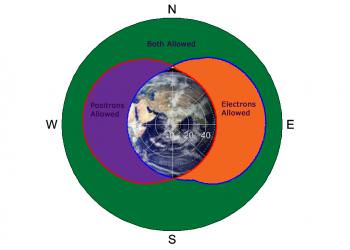[/caption]
A couple of years ago, the Payload for Antimatter Matter Exploration and Light-nuclei Astrophysics, PAMELA, sent us back some curious information… an overload of anti-matter in the Milky Way. Why does this member of the cosmic ray spectrum have interesting implications to the scientific community? It could mean the proof needed to confirm the existence of dark matter.
By employing the Fermi Large Area Telescope, researchers with the Kavli Institute for Particle Astrophysics and Cosmology (KIPAC) at Stanford University were able to verify the results of PAMELA’s findings. What’s more, by being in the high energy end of the spectrum, these abundances seem to verify current thinking on dark matter behavior and how it might produce positrons.
“There are various theories, but the basic idea is that if a dark matter particle were to meet its anti-particle, both would be annihilated. And that process of annihilation would generate new particles, including positrons.” says Stephan Funk, an assistant professor at Stanford and member of KIPAC. “When the PAMELA experiment looked at the spectrum of positrons, which means sampling positrons across a range of energy levels, it found more than would be expected from already understood astrophysics processes. The reason PAMELA generated such excitement is that it’s at least possible the excess positrons are coming from annihilation of dark matter particles.”
But there has been a glitch in what might have been a smooth solution. Current thinking has the positron signal dropping off when it reaches a specific level – a finding which wasn’t verified and led the researchers to feel the results were inconclusive. But the research just didn’t end there. The team consisting of Funk, Justin Vandenbroucke, a postdoc and Kavli Fellow and avli-supported graduate student Warit Mitthumsiri, came up with some creative solutions. While the Fermi Gamma-ray Space Telescope can’t distinguish between negatively charged electrons and positively charged positrons without a magnet – the group came up with their needs just a few hundred miles away.
Earth’s own magnetic field…

“The thing that was most fun about this analysis for me is its interdisciplinary nature. We absolutely could not have made the measurement without this detailed map of the Earth’s magnetic field, which was provided by an international team of geophysicists. So to make this measurement, we had to understand the Earth’s magnetic field, which meant poring over work published for entirely different reasons by scientists in another discipline altogether.” said Vandenbroucke. “The big takeaway here is how valuable it is to measure and understand the world around us in as many ways as possible. Once you have this basic scientific knowledge, it’s often surprising how that knowledge can be useful.”
Oddly enough, they still came up with more than the expected amount of antimatter positrons as previously reported in Nature. But again, the findings didn’t show the theoretical drop-off that was to be expected if dark matter were involved. Despite these inconclusive results, it’s still a unique way of looking at difficult studies and making the most of what’s at hand.
“I find it to be fascinating to try to get the most out of an astrophysical instrument and I think we did that with this measurement. It was very satisfying that our approach, novel as it was, seemed to work so well. Also, you really have to go where the science takes you.” says Funk. “Our motivation was to confirm the PAMELA results because they are so exciting and unexpected. And as far as understanding what the Universe is actually trying to tell us here, I think it was important that PAMELA results were confirmed by a completely different instrument and technique.”
Original Story Source: Kavli Foundation News Release. For Further Reading: Measurement of separate cosmic-ray electron and positron spectra with the Fermi Large Area Telescope.

